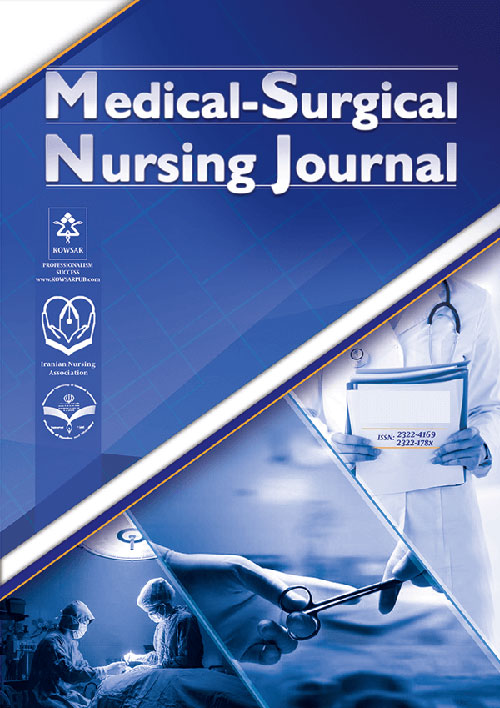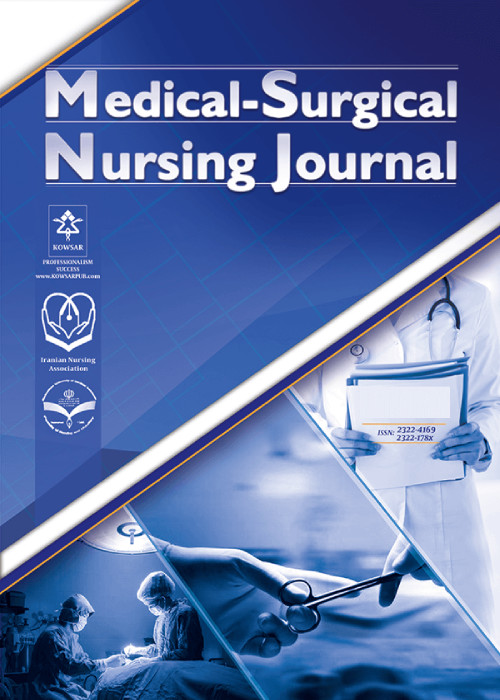فهرست مطالب

Iranian Journal Of Medical - Surgical Nursing
Volume:10 Issue: 2, May 2021
- تاریخ انتشار: 1400/09/04
- تعداد عناوین: 6
-
-
Page 1Background
Cancer causes psychological problems, such as anxiety, depression, post-traumatic stress, feelings of sadness, and anger, and family problems.
ObjectivesThis study aimed to evaluate the effect of schema therapy on psychological capital and vulnerable attachment in women with breast cancer.
MethodsThe research method was quasi-experimental with a pretest-posttest design and a control group. The statistical population included all women with breast cancer admitted to the Imam Khomeini Hospital, Tehran, Iran, from 23/07/2019 to 20/11/2019. The total number of the patients was 51, of whom 30 were purposefully selected and randomly assigned to an experimental and a control group (15 people in each group). The experimental group was exposed to schema therapy for 11 weekly 90-minute sessions, while the control group did not receive any training. The Luthans Psychological Capital Questionnaire and the Vulnerable Attachment Questionnaire were used to collect data. The collected data were analyzed using multivariate analysis of covariance in SPSS-21 software.
ResultsThe results of paired t-test showed a significant difference between the mean scores of the components of psychological capital and vulnerable attachment in the two experimental and control groups. Therefore, it can be stated that the effectiveness of schema therapy was associated with increased self-efficacy (P = 0.013), hope (P = 0.001), resilience (P = 0.034), optimism (P = 0.001), and decreased vulnerable attachment (P = 0.029).
ConclusionsBased on the findings of this study regarding the effect of schema therapy on improving psychological capital and reducing vulnerable attachment, it can be concluded that schema therapy can be used as an effective intervention along with other therapies to reduce the problems of women with breast cancer.
Keywords: Schema Therapy, Self-efficacy, Hope, Resilience Psychological, Optimism, Psychology, Object Attachment, Breast Cancer -
Page 2Background
The American Academy of Pediatrics and the National Association of Neonatal Nurses recommend that palliative care be provided as standard care in neonatal intensive care units (NICUs).
ObjectivesThe present study aimed to explain the nurses’ experiences of barriers to palliative care in NICUs.
MethodsThis qualitative study was conducted using the content analysis approach in NICUs of Beheshti and Amin hospitals in Isfahan in 2020. The data were collected using semi-structured in-depth interviews with 12 nurses who had palliative and end-of-life care experiences for infants and families. The nurses were selected using purposive sampling. The duration of each interview varied from 25 to 50 minutes. Data were analyzed using conventional qualitative content analysis conducted inductively with Graham and Lundman’s approach. The criteria proposed by Guba and Lincoln were used to ensure the credibility and reliability of the data.
ResultsThree main categories were extracted from the data, including unfavorable conditions (subcategorized into “unsuitable physical environment” and “shortage of nurses”), nurse’s mental problems (with the subcategories of “nurses’ mental problems in providing neonatal care” and “nurses’ mental problems in providing family care”) and challenges ahead (with the subcategories of "parental presence challenge” and “doctor’s instructions challenge”).
ConclusionsThe findings of the present study revealed the barriers to palliative care for infants and families in NICUs. Given the importance of palliative care in NICUs, effective measures must be taken to overcome these barriers.
Keywords: Neonatal Intensive Care Unit, Palliative Care, Qualitative Research -
Page 3Background
Breast cancer patients who undergo mastectomy encounter numerous problems, the most annoying of which is lymphedema followed by pain and decreased function in the affected limb.
ObjectivesThis study examined the effect of self-care training on upper limb function and pain after breast surgery.
MethodsThis quasi-experimental study was performed on two groups of 60 patients with breast cancer in the Oncology Ward of Zahedan University of Medical Sciences in 2021. The patients were selected based on the inclusion criteria and through convenience sampling and were then randomly divided into intervention and control groups. The patients in the intervention group attended self-care training and exercise programs implemented in five sessions in addition to the routine care. One and three months after the intervention, upper limb function and pain were measured with DASH and McGill pain questionnaires. The repeated measures analysis of variance (ANOVA) and Bonferroni test were used to compare the pre-, and post-intervention mean scores and mean differences in the two groups.
ResultsThe mean scores of upper limb function one and three months after the training program in the intervention group were lower than the mean scores of the control group. In other words, the quality of upper limb function was not significantly different despite the changes in the first month, but upper limb function significantly improved three months after the intervention (P < 0.001 vs. P = 0.06). The mean pain scores before, one month, and three months after the intervention in the intervention group were 10.4, 35.7, and 6.26, respectively, and the corresponding values in the control group were 10.8, 41.7, and 21.1, respectively, showing significant differences between the two groups, with the intervention group having lower pain scores than the control group (P = 0.001).
ConclusionsSince lymphedema and its consequences, including decreased upper limb function and pain, are very serious issues, medical staff can give priority to this training program and implement it to prevent and control these complications.
Keywords: Breast Cancer, Function, Pain, Self-care, Training -
Page 4Background
Long-term care of the children with epilepsy and lack of psycho-educational training will lead to caregiver burden.
ObjectivesThe aim of this study was to evaluate the effect of a psycho-educational training program on caregiver burden in families with pediatric epileptic children.
MethodsThis is a clinical trial study with two groups of experimental and control with three stages of Before, Immediately later, One month after the intervention. The population of the study consisted of family caregivers of children with epilepsy referring to Imam Hossein and Kashani Hospitals in Isfahan, Iran. Seventy families of children (ages 6 - 18years) with epilepsy participated in this study in 2018. The samples were randomly assigned to experimental (35) and control (35) groups using sequential convenience sampling method. The experimental group received a psycho-educational training program in eight sessions (90-minute) in four groups (8 - 9 members), and training was held two sessions a week. The control group participated in three sessions and expressed their problems and experiences. Data were collected using a demographic questionnaire and Zarit Burden Interview (ZBI) that consisted of 22 items and a 5-point Likert scale. Descriptive and inferential statistical methods and SPSS18 were used for data analysis.
ResultsBefore the intervention, there was no statistically significant difference between the two groups of experimental and control in terms of caregiver burden (P = 0.917). However, there was a significant difference between the three time stages in the intervention group after the intervention (P < 0.05; f = 3.511). Meanwhile, the mean score of caregiver burden decreased during the intervention period than before the study (P < 0.05; f = 166.60), while the mean score of caregiver burden did not increase significantly in the control group over time (P = 0.036).
ConclusionsThe results showed that in a family with school-age epileptic children, appropriate programs and training methods are needed to decrease caregiver burden; so it is necessary to develop and use such programs by the treatment team members.
Keywords: Children, School Age, Epilepsy, Family Caregivers, Psycho-Educational Training, Caregiver Burden -
Page 5Background
Postoperative pain is a common and significant complication, and there are several ways to control it. In recent years, there has been a growing tendency to use pregabalin to control pain.
ObjectivesThis study aimed to compare the effects of two different doses of pregabalin on postoperative pain after lumbar disc herniation surgery.
MethodsThis clinical trial study was performed on 90 patients undergoing elective herniated disc surgery in Khatam Al-Anbia Hospital of Zahedan, Iran, using random sampling. The patients were divided into three groups, including those receiving high dose pregabalin (150 mg), low dose pregabalin (75 mg), and placebo. The three groups were compared regarding postoperative pain, the received dose of analgesic, and the severity of side effects. The data were analyzed based on the Chi-square test and oneway analysis of variance using SPSS software (version 18).
ResultsIn this study, the mean age of the patients was 43.9±6.7 years. The mean postoperative pain was significantly lower in both pregabalin groups than the placebo group (P < 0.05). Moreover, the mean postoperative pain in the high-dose pregabalin group was less than that of the low-dose group; however, the difference was not statistically significant (P > 0.05). Analgesics were needed for 8 patients (26.7%) of the low-dose pregabalin group. Furthermore, 7 patients (23.3%) of the high-dose pregabalin group and 16 patients (53.3%) of the placebo group also needed analgesics (P = 0.028). Additionally, 5 (16.7%), 8 (26.7%), and 4 (13.3%) patients in the low-dose pregabalin group, high-dose pregabalin group, and placebo group complained of side effects (P = 0.390).
ConclusionsThe present study showed that pregabalin significantly reduces postoperative pain and the required dose of analgesia. On the other hand, pregabalin complications are minor and can be neglected.
Keywords: Pregabalin, Lumbar Disc Herniation, Postopoperative Analgesia -
Page 6Background
It is important to resume regular functions of the digestive system as soon as possible after surgery. It has been reported that chewing gum can be used in this regard.
ObjectivesThis study aimed to evaluate the effect of chewing gum on nausea-vomiting and bowel function in surgical patients.
MethodsA total of 60 patients with cholecystectomy and herniotomy (30 controls [non-chewing gum] and 30 interventions [chewing gum]) were enrolled in this controlled experimental study. The intervention group was provided to chew gum 3 times for 15 - 30 minutes with a 2-hour interval. Both control and intervention groups were evaluated 6 and 24 hours after being taken to the surgical service using the nausea-vomiting, intestinal functions monitoring form.
ResultsA statistically significant difference was found between the control and intervention groups 0 - 6 hours after surgery (χ2 = 4.320, P < 0.05). The intervention group was found to be discharged earlier than the control group (χ² = 4.286, P < 0.05; Z = -2.053, P < 0.05), and the difference was significant. It was found that the intervention group suffered 5.09 times less vomiting compared to the control group 0 - 6 hours after surgery.
ConclusionsThe positive effects of chewing gum on nausea, vomiting, intestinal function, and early discharge were found. It is recommended that chewing gum be included in nursing interventions for patients after surgery.
Keywords: Chewing Gum, General Surgery, Postoperative Nausea, Vomiting, Intestines


